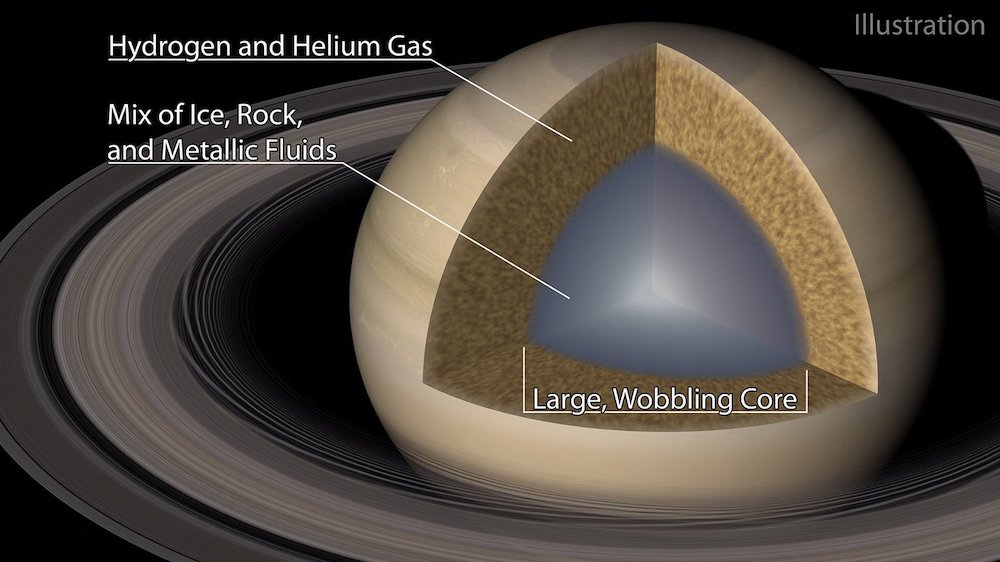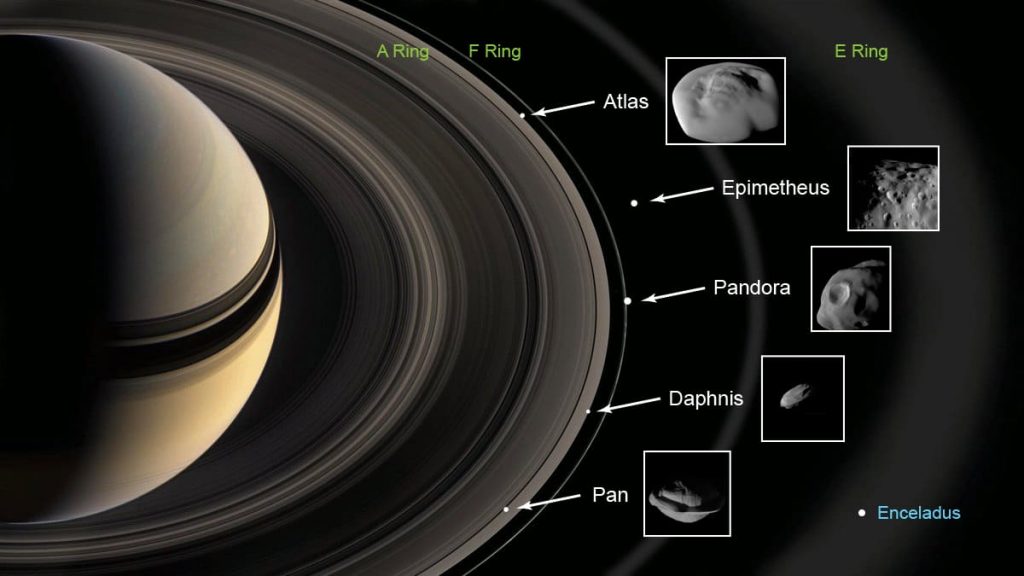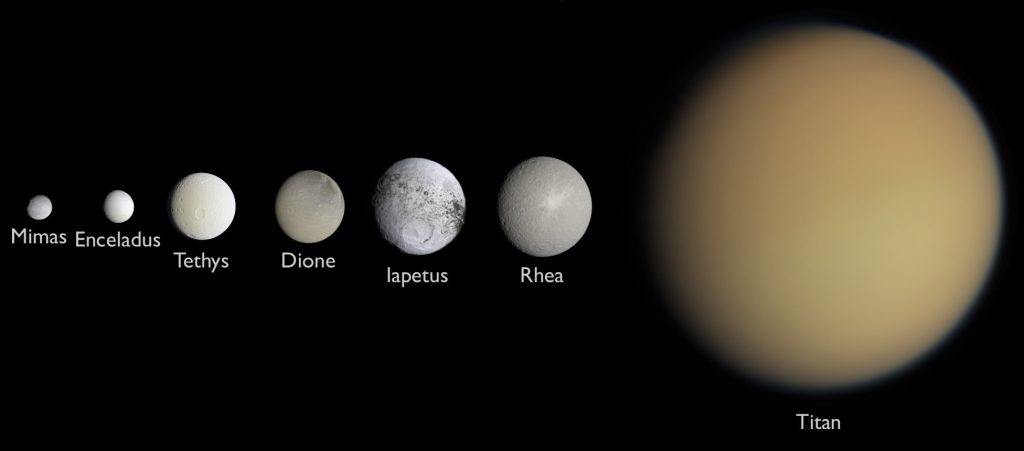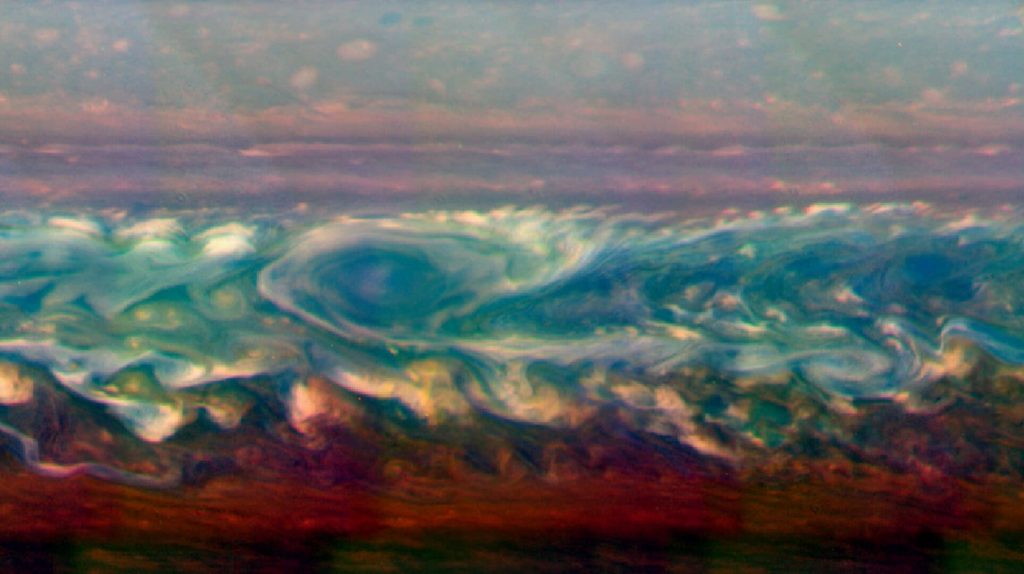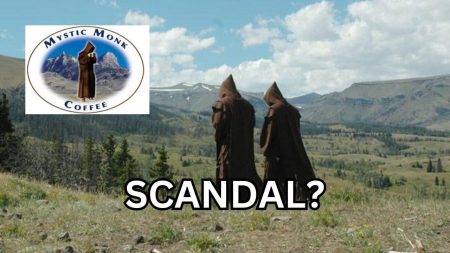“How Big Is Saturn?” is a question that sparks curiosity and wonder. Saturn, often recognized for its striking rings, is the sixth planet from the Sun in our solar system. It holds the title of being the second-largest planet, surpassed only by Jupiter.
This gas giant is primarily composed of hydrogen and helium, similar to the Sun. Its grandeur and unique features have made it a subject of fascination for astronomers and space enthusiasts alike.
Saturn’s prominence in our solar system is not just due to its size, but also its complex ring system and numerous moons. The planet’s rings are a spectacle of cosmic beauty, while its moons are intriguing worlds, each with its own unique characteristics.
Despite its size and composition, one of the most fascinating aspects of Saturn is its density. Believe it or not, this massive planet has a lower density than water. This leads to an interesting question: Can Saturn float on water? As we delve deeper into the details of Saturn’s size and density, we’ll explore this question and many more.
In the following sections, we’ll take a closer look at Saturn’s size, its composition, the spectacular ring system, and its numerous moons.
We’ll also discuss the intriguing possibility of Saturn floating on water. So, let’s embark on this cosmic journey to understand the grandeur of Saturn, the mighty gas giant of our solar system.
Table of Contents
The Size of Saturn
| Characteristic | Value |
|---|---|
| Mass | 568.34 billion billion kilograms |
| Radius | 60,268 kilometers |
| Density | 0.687 grams per cubic centimeter |
| Number of Moons | 82 |
| Atmosphere Composition | Hydrogen (96.3%), Helium (3.25%), Trace amounts of Methane, Ammonia, Water Vapor |
When we talk about the size of Saturn, the numbers are truly astronomical.
To put it into perspective, Saturn’s radius measures a staggering 36,183.7 miles (58,232 kilometers), making it about nine times wider than Earth.
If you were to compare Earth to Saturn, it’s akin to comparing a nickel to a volleyball. This immense size makes Saturn the second-largest planet in our solar system, only falling short of Jupiter.
Saturn’s shape is another interesting aspect of its physical characteristics. Unlike a perfect sphere, Saturn takes on an oblate spheroid shape.
This means it’s flattened at the poles and bulging at the equator, a result of its rapid rotation. In fact, the polar radius of Saturn is about 90 percent of its equatorial radius.
This rapid rotation also causes the planet to have the second-shortest day in the solar system, with one day on Saturn taking only 10.7 hours.
If you were to take a stroll around Saturn’s equator (hypothetically, of course), you’d be in for quite a long walk.
The circumference of Saturn at its equator is approximately 227,349 miles (365,882 kilometers). That’s nearly the same distance as walking around the Earth’s equator nine times!
Saturn’s Composition
Saturn, often referred to as a ‘gas giant’, is predominantly composed of two elements: hydrogen and helium.
These elements are also the primary constituents of the Sun, making Saturn a miniature version of our star in terms of composition.
However, unlike the Sun, Saturn lacks a solid surface. Instead, it is a swirling mass of gases and liquids that become denser as you move towards the planet’s core.
| Layer | Composition |
|---|---|
| Outer Layers | Molecular Hydrogen |
| Middle Layer | Metallic Hydrogen |
| Core | Iron, Nickel, Rocky Material |
The outer layers of Saturn are composed of molecular hydrogen, transitioning to a layer of metallic hydrogen towards the core.
This metallic hydrogen layer is a state of hydrogen under immense pressure, where it behaves like an electrical conductor. This layer is crucial as it contributes to Saturn’s strong magnetic field.
At the heart of Saturn lies a dense core, believed to be about the size of Earth. This core is composed of heavier elements, primarily metals like iron and nickel, surrounded by rocky material and other compounds.
These elements are solidified by the intense pressure and heat at the core. The temperature at Saturn’s core is estimated to be a scorching 21,000 degrees Fahrenheit (11,700 degrees Celsius), hotter than the surface of the Sun!
Saturn’s Rings
One of the most iconic features of Saturn is its spectacular ring system. These rings are the most extensive and visually stunning in the entire solar system.
When viewed through a telescope, they present a breathtaking sight, making Saturn one of the most recognizable planets.
| Characteristic | Description |
|---|---|
| Composition | Water-Ice, Rock, Dust |
| Extent | Up to 175,000 miles from Saturn |
| Thickness | About 30 feet |
| Origin | Remnants of comets, asteroids, or moons |
| Structure | Countless individual particles |
| Main Rings | A, B, and C rings |
Saturn’s rings are composed primarily of countless chunks of water-ice, with sizes ranging from tiny dust grains to massive chunks as big as mountains.
These ice particles are mixed with pieces of rock and dust, all orbiting Saturn in a thin, flat plane.
The rings extend up to 175,000 miles (282,000 kilometers) from the planet but are surprisingly thin, with a thickness of about 30 feet (10 meters) in most parts.
The origin of Saturn’s rings has been a subject of scientific debate.
One popular theory suggests that the rings are remnants of comets, asteroids, or moons that were shattered by Saturn’s strong gravitational pull before they could reach the planet’s surface.
These fragments then spread out around the planet, forming the rings we see today.
The rings are not a solid disk but are made up of countless individual particles, each orbiting Saturn independently.
They are named alphabetically in the order they were discovered, with the main rings being the A, B, and C rings. The B ring is the brightest and most massive of the rings, while the A and C rings are less dense and more transparent.
Saturn’s rings are a dynamic and active system, with complex interactions between the particles and Saturn’s many moons.
Saturn’s Moons
Saturn’s celestial family is vast, with the planet boasting a staggering 83 moons, 63 of which have been confirmed and named.
This makes Saturn the planet with the second-highest number of moons in our solar system, only surpassed by Jupiter.
These moons vary greatly in size and characteristics.
Some are tiny moonlets only a few kilometers across, while others are giant bodies with diameters of thousands of kilometers. Each moon orbits Saturn at a different distance and speed, creating a complex and dynamic system.
| Moon | Radius | Mass |
|---|---|---|
| Phoebe | 106.5 km | 4 x 10^18 kg |
| Hyperion | 133.0 km | 5.6 x 10^18 kg |
| Mimas | 198.2 km | 3.75 x 10^19 kg |
| Enceladus | 252.1 km | 8.4 x 10^19 kg |
| Tethys | 531.1 km | 6.18 x 10^20 kg |
| Dione | 561.4 km | 1.1 x 10^21 kg |
| Iapetus | 734.5 km | 1.81 x 10^21 kg |
| Rhea | 763.8 km | 2.31 x 10^21 kg |
| Titan | 2574.7 km | 1.35 x 10^23 kg |
The largest and most famous of Saturn’s moons is Titan, which is the second-largest moon in the solar system, only smaller than Jupiter’s Ganymede.
Titan is larger than the planet Mercury and is the only moon known to have a dense atmosphere and stable bodies of surface liquid.
It’s a world of its own, with lakes of liquid methane and ethane, and it’s considered one of the most likely places in the solar system to potentially host extraterrestrial life.
Another notable moon is Enceladus, which is much smaller than Titan but has gained fame due to its geysers that spew water vapor and ice particles from an underground ocean into space.
These geysers make Enceladus one of the few bodies in the solar system known to have ongoing geological activity.
Saturn’s moons play a crucial role in shaping the planet’s rings. Some moons, known as shepherd moons, help maintain the shape and structure of the rings, while others create gaps within the rings.
Can Saturn Float on Water?
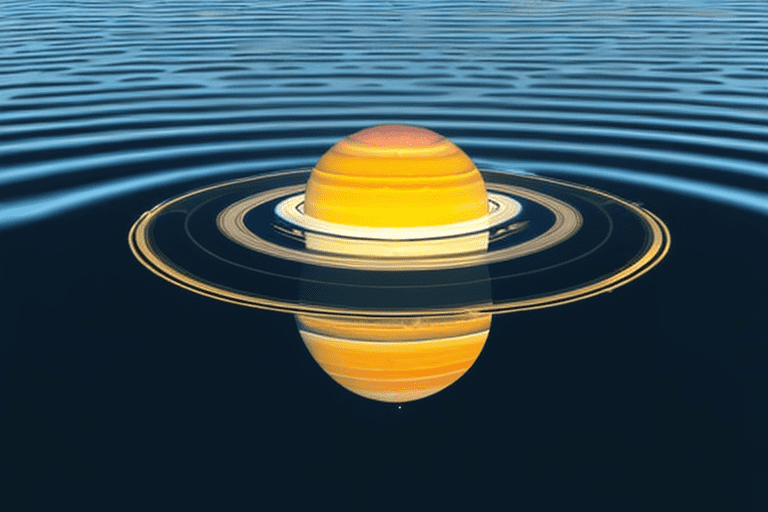
One of the most intriguing questions about Saturn is whether it could float on water.
This question arises from the fact that Saturn’s mean density is only 0.687 grams per cubic centimeter, which is less than the density of water (1 gram per cubic centimeter). This makes Saturn the only planet in our solar system that is less dense than water.
But what does this mean in practical terms? If we could find an ocean large enough, Saturn would theoretically float like an apple in a barrel of water.
This is a fascinating concept, but it’s important to remember that this is purely hypothetical.
In reality, there’s no body of water large enough to test this theory, and the immense size of Saturn would cause any real-world body of water to be influenced by Saturn’s own gravity.
This low density also has implications for the structure of Saturn. It’s one of the reasons why Saturn lacks a solid surface.
Instead, the planet is composed of layers of gas and liquid that become denser as you move towards the core.
If you were to ‘stand’ on Saturn, you would sink into the planet, gradually transitioning from the upper atmosphere to the denser layers below.
Saturn’s Atmosphere
Saturn’s atmosphere is a dynamic and complex system, characterized by faint stripes, jet streams, and storms.
It’s composed primarily of hydrogen and helium, similar to the planet’s overall composition.
However, trace amounts of other chemicals in the atmosphere result in a variety of colors, giving Saturn its distinctive yellow-brown appearance.
The stripes visible on Saturn are due to the planet’s zonal winds. These winds create bands of different colors, much like the famous bands seen on Jupiter.
However, Saturn’s bands are much fainter and wider. The bands are a result of the planet’s rapid rotation and the heat rising from its interior, creating a pattern of alternating warm and cool atmospheric bands.
One of the most fascinating features of Saturn’s atmosphere is its storms. These storms can be massive, sometimes even larger than Earth.
They are often accompanied by powerful lightning, with bolts that can be up to 10,000 times more powerful than those on Earth.
Perhaps the most unique feature of Saturn’s atmosphere is the six-sided jet stream found at the planet’s north pole, known as the hexagon.
This hexagonal cloud pattern is a result of a high-speed jet stream with winds moving at around 200 miles per hour (322 kilometers per hour).
The hexagon is so large that four Earths could fit inside it. This feature is unique to Saturn and is not found on any other planet in our solar system.
Conclusion
As we conclude our cosmic journey, it’s clear that Saturn is a marvel of the solar system. Its immense size, stunning ring system, and numerous moons make it a standout among the celestial bodies that orbit our Sun.
We’ve explored Saturn’s size, revealing that it’s about nine times wider than Earth. Its oblate spheroid shape, a result of its rapid rotation, and its vast equatorial circumference further emphasize its grand scale.
We’ve delved into Saturn’s composition, a swirling mass of hydrogen and helium with a dense core of metals. This composition, coupled with its low density, leads to the fascinating possibility that Saturn could float on water, a testament to the planet’s unique physical properties.
Saturn’s ring system, the most extensive and visually stunning in the solar system, and its 83 moons, each with unique characteristics, add to the planet’s intrigue. From Titan with its dense atmosphere to Enceladus with its geysers, Saturn’s moons are worlds of their own.
Saturn’s atmosphere, with its faint stripes, jet streams, and storms, and the unique six-sided jet stream at its north pole, showcase the dynamic and complex nature of this gas giant.
FAQs on “How Big Is Saturn?”
Saturn is about nine times wider than Earth. Its radius measures approximately 36,183.7 miles (58,232 kilometers), compared to Earth’s radius of about 3,959 miles (6,371 kilometers).
Saturn is predominantly composed of hydrogen and helium, similar to the Sun. It also has a dense core of metals like iron and nickel, surrounded by rocky material and other compounds solidified by intense pressure and heat.
Saturn’s rings are thought to be remnants of comets, asteroids, or moons that were shattered by Saturn’s strong gravitational pull before they could reach the planet’s surface. These fragments then spread out around the planet, forming the rings we see today.
As of the latest count, Saturn has 82 known moons, 63 of which have been confirmed and named. The largest and most famous of Saturn’s moons is Titan, which is the second-largest moon in the solar system.
Theoretically, yes. Saturn’s mean density is only 0.687 grams per cubic centimeter, which is less than the density of water (1 gram per cubic centimeter). This means that if you could find a body of water large enough, Saturn would float. However, in reality, there’s no body of water large enough to test this theory, and Saturn’s immense size would cause any real-world body of water to be influenced by Saturn’s own gravity.
Sources:
Also Read:
- 100 Facts About Saturn: Fascinating Mysteries of the Ringed Planet
- The Strange Story of Albert Einstein’s Brain After Death & The Key Findings
- Are Teeth Bones? Why Are Teeth Not Considered Bones?
- 3 Reasons Why School Buses Are Yellow In Color
- Strange case of Vasu Bhanot – Parallel Universe in Nainital, India

